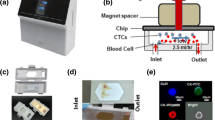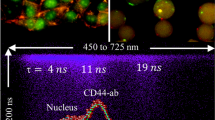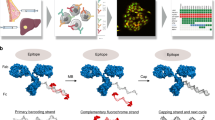Abstract
Background
SNAP-tag, a self-labeling protein tag, is commonly used for in vitro and in vivo analysis of bound target proteins. We report the first evidence that SNAP-tag could be used for ex vivo detection of enriched biological markers.
Methods
Proof of concept was established for target c-kit receptor, a pathological and diagnostic marker for a variety of cancers. SNAP-tag conjugates with stem-cell factor (SCF) fusion proteins were designed and their binding and specificity was validated in vitro using flow cytometry and immunostaining.
Results
Ex vivo diagnostic application of the fusion protein was demonstrated in comparison with anti-c-kit antibody for peripheral blood samples from leukemia patients and colorectal tissue specimens.





Similar content being viewed by others
References
Robinson KS, Williams ME, van der Jagt RH, Cohen P, Herst JA, Tulpule A, et al. Phase II multicenter study of bendamustine plus rituximab in patients with relapsed indolent B-cell and mantle cell non-Hodgkin’s lymphoma. J Clin Oncol. 2008;26(27):4473–9.
Bosch Peter J, Corrêa Jr Ivan R, Sonntag Michael H, Ibach J, Brunsveld L, Kanger Johannes S, et al. Evaluation of fluorophores to label SNAP-tag fused proteins for multicolor single-molecule tracking microscopy in live cells. Biophys J. 2014;107(4):803–14. doi:10.1016/j.bpj.2014.06.040.
Grimm JB, English BP, Chen J, Slaughter JP, Zhang Z, Revyakin A, et al. A general method to improve fluorophores for live-cell and single-molecule microscopy. Nat Meth. 2015;12(3):244–50. doi:10.1038/nmeth.3256.
Gautier A, Juillerat A, Heinis C, Corrêa IR, Kindermann M, Beaufils F, et al. An engineered protein tag for multiprotein labeling in living cells. Chemi Biol. 2008;15(2):128–36.
Day JJ, Marquez BV, Beck HE, Aweda TA, Gawande PD, Meares CF. Chemically modified antibodies as diagnostic imaging agents. Curr Opin Chem Biol. 2010;14(6):803–9. doi:10.1016/j.cbpa.2010.09.015.
Kampmeier F, Niesen J, Koers A, Ribbert M, Brecht A, Fischer R, et al. Rapid optical imaging of EGF receptor expression with a single-chain antibody SNAP-tag fusion protein. Eur J Nucl Med l. 2010;37(10):1926–34. doi:10.1007/s00259-010-1482-5.
Kampmeier F, Ribbert M, Nachreiner T, Dembski S, Beaufils F, Brecht A, et al. Site-specific, covalent labeling of recombinant antibody fragments via fusion to an engineered version of 6-O-alkylguanine DNA alkyltransferase. Bioconjugate Chem. 2009;20(5):1010–5. doi:10.1021/bc9000257.
Amoury M, Blume T, Brehm H, Niesen J, Tenhaef N, Barth S, et al. SNAP-tag based agents for preclinical in vitro imaging in malignant diseases. Curr Pharm Design. 2013;19(30):5429–36. doi:10.2174/13816128113199990405.
Yarden Y, Kuang W-J, Yang-Feng T, Coussens L, Munemitsu S, Dull TJ, et al. Human proto-oncogene c-kit: a new cell surface receptor tyrosine kinase for an unidentified ligand. EMBO J. 1987;6(11):3341.
Sperling C, Schwartz S, Büchner T, Thiel E, Ludwig W-D. Expression of the stem cell factor receptor C-KIT (CD117) in acute leukemias. Haematologica. 1997;82(5):617–21.
Bene M, Nebe T, Bettelheim P, Buldini B, Bumbea H, Kern W, et al. Immunophenotyping of acute leukemia and lymphoproliferative disorders: a consensus proposal of the European LeukemiaNet Work Package 10. Leukemia. 2011;25(4):567–74.
Osman IM, Humeida AAK, Eltayeb O, Abdelrhman I, Elhadi TA. Flowcytometric Immunophenotypic characterization of acute myeloid leukemia (AML) in Sudan. Int J Hematol Disorder. 2015;2(1):10–7.
Cascavilla N, Musto P, D’Arena G, Melillo L, Carella AM, Petrilli MP, et al. CD117 (c-kit) is a restricted antigen of acute myeloid leukemia and characterizes early differentiative levels of M5 FAB subtype. Haematologica. 1998;83(5):392–7.
Giannopoulos A, Papaconstantinou I, Alexandrou P, Petrou A, Papalambros A, Felekouras E, et al. Poorly differentiated carcinoma of the rectum with aberrant immunophenotype: a case report. World J Gastroenterol. 2007;13(44):5951–3. doi:10.3748/wjg.v13.i44.5951.
Cohen PS, Chan JP, Lipkunskaya M, Biedler JL, Seeger RC. Expression of stem cell factor and c-kit in human neuroblastoma. The Children’s Cancer Group. Blood. 1994;84(10):3465–72.
Hibi K, Takahashi T, Sekido Y, Ueda R, Hida T, Ariyoshi Y, et al. Coexpression of the stem cell factor and the c-kit genes in small-cell lung cancer. Oncogene. 1991;6(12):2291–6.
Hirota S, Isozaki K, Moriyama Y, Hashimoto K, Nishida T, Ishiguro S, et al. Gain-of-function mutations of c-kit in human gastrointestinal stromal tumors. Science. 1998;279(5350):577–80.
Blair A, Sutherland HJ. Primitive acute myeloid leukemia cells with long-term proliferative ability in vitro and in vivo lack surface expression of c-kit (CD117). Exp Hematol. 2000;28(6):660–71. doi:10.1016/S0301-472X(00)00155-7.
Döhner H, Estey EH, Amadori S, Appelbaum FR, Büchner T, Burnett AK, et al. Diagnosis and management of acute myeloid leukemia in adults: recommendations from an international expert panel, on behalf of the European LeukemiaNet. Blood. 2010;115(3):453–74.
Bene M, Castoldi G, Knapp W, Ludwig W, Matutes E, Orfao A, et al. Proposals for the immunological classification of acute leukemias. European Group for the Immunological Characterization of Leukemias (EGIL). Leukemia. 1995;9(10):1783–6.
Arntz C, Greb W, Inventors; Google Patents, assignee. CD44 binding peptides 2015.
Stöcker M, Tur MK, Sasse S, Krüßmann A, Barth S, Engert A. Secretion of functional anti-CD30-angiogenin immunotoxins into the supernatant of transfected 293T-cells. Protein Expres Purif. 2003;28(2):211–9.
Zhang Z, Zhang R, Joachimiak A, Schlessinger J, Kong X-P. Crystal structure of human stem cell factor: Implication for stem cell factor receptor dimerization and activation. Proc Natl Acad Sci USA. 2000;97(14):7732–7. doi:10.1073/pnas.97.14.7732.
Akuta T, Kikuchi-Ueda T, Imaizumi K, Oshikane H, Nakaki T, Okada Y, et al. Expression of bioactive soluble human stem cell factor (SCF) from recombinant Escherichia coli by coproduction of thioredoxin and efficient purification using arginine in affinity chromatography. Protein Expr Purif. 2015;105:1–7. doi:10.1016/j.pep.2014.09.015.
Chen T, Yang J, Wang Y, Zhan C, Zang Y, Qin J. Design of recombinant stem cell factor–macrophage colony stimulating factor fusion proteins and their biological activity in vitro. J Comput Aided Mol Des. 2005;19(5):319–28. doi:10.1007/s10822-005-5686-x.
Creutzig U, van den Heuvel-Eibrink MM, Gibson B, Dworzak MN, Adachi S, de Bont E, et al. Diagnosis and management of acute myeloid leukemia in children and adolescents: recommendations from an international expert panel. Blood. 2012;120(16):3187–205.
Nomdedéu JF, Mateu R, Altès A, Llorente A, Rio C, Estivill C, et al. Enhanced myeloid specificity of CD 117 compared with CD13 and CD33. Leukemia Res. 1999;23(4):341–7.
Gao X, Lin J, Gao L, Deng A, Lu X, Li Y, et al. High expression of c-kit mRNA predicts unfavorable outcome in adult patients with t (8; 21) acute myeloid leukemia. PLoS One. 2015;10(4):e0124241. doi:10.1371/journal.pone.0124241.
Pracht M, Mogha A, Lespagnol A, Fautrel A, Mouchet N, Le Gall F, et al. Prognostic and predictive values of oncogenic BRAF, NRAS, c-KIT and MITF in cutaneous and mucous melanoma. J Eur Acad Dermatol. 2015;29(8):1530–8. doi:10.1111/jdv.12910.
La Rosa S, Marando A, Furlan D, Sahnane N, Capella C. Colorectal poorly differentiated neuroendocrine carcinomas and mixed adenoneuroendocrine carcinomas: insights into the diagnostic immunophenotype, assessment of methylation profile, and search for prognostic markers. Am J Surg Pathol. 2012;36(4):601–11. doi:10.1097/PAS.0b013e318242e21c.
Corless CL, Heinrich MC. Molecular pathobiology of gastrointestinal stromal sarcomas. Ann Rev Pathol. Mech Disease. 2008;3:557–86.
Micke P, Basrai M, Faldum A, Bittinger F, Rönnstrand L, Blaukat A, et al. characterization of c-kit expression in small cell lung cancer: prognostic and therapeutic implications. Clin Cancer Res. 2003;9(1):188–94.
Acknowledgements
We would like to thank Ahmad Fawzi Hussain, Alessa Pardo and Reinhard Rosinke (Department of Pharmaceutical Product Development, Fraunhofer Institute for Molecular Biology and Applied Ecology) for their assistance with labeling experiments and protein purification, respectively, and DAAD and MHRD for providing fellowships to SC.
Author information
Authors and Affiliations
Corresponding authors
Ethics declarations
Conflict of interest
SC, SB and RSV declare that they have no conflict of interest.
Funding
This work was funded by the block grants at Indian Institute of Technology Madras and Fraunhofer IME.
Ethical approval
All procedures performed in studies involving human participants were in accordance with The Code of Ethics of the World Medical Association (Declaration of Helsinki) for experiments involving humans and were approved by the Indian Institute of technology Madras Institutional Review Board (IEC/2016/01/RSV-6/22). Informed consent was obtained from all individual participants included in the study.
Additional information
S. Barth and R. S. Verma contributed equally to this work.
Rights and permissions
About this article
Cite this article
Choudhary, S., Barth, S. & Verma, R.S. SNAP-Tag Technology: A Promising Tool for Ex Vivo Immunophenotyping. Mol Diagn Ther 21, 315–326 (2017). https://doi.org/10.1007/s40291-017-0263-2
Published:
Issue Date:
DOI: https://doi.org/10.1007/s40291-017-0263-2




